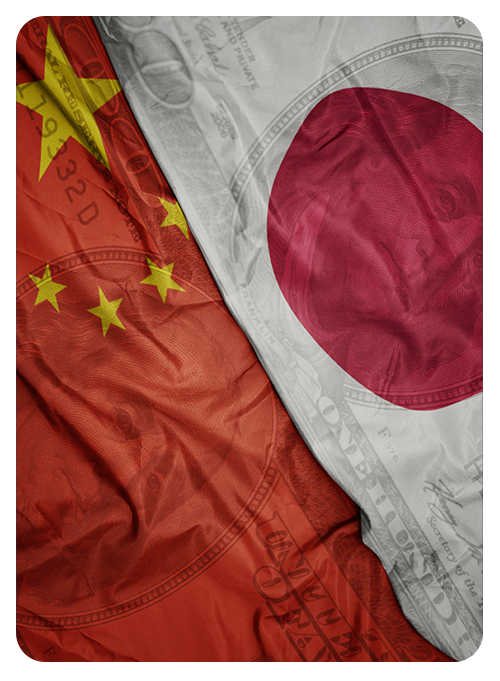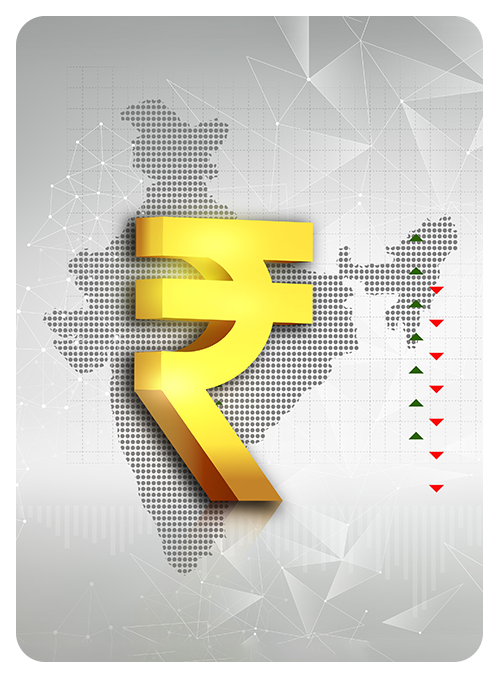Finsphere
From Rebound to Retaliation:
Nifty Falls as US Tariffs Trigger Global Sell-Off

Dear Clients and Stakeholders,
Indian equity markets enjoyed some much-needed relief in March, snapping a five month sell off which started last October as Nifty rebounded 6.3%. However, this optimism was short-lived. President Trump’s announcement of sweeping new tariffs reignited global trade tensions, sending Nifty tumbling 2.61% in the first week of April. With corporate earnings for Q4FY25 around the corner and fears of a full-blown trade war setting in, investor sentiment has once again turned cautious.
President Trump, on April 3rd, announced a baseline 10% “reciprocal tariff” on virtually all of US’s trading partners, effective from April 5th, 2025, along with higher country-specific tariffs ranging from 10% to as high as 54%, set to begin April 9. Notably, previously tariffed items like steel, aluminum, and auto components (already subject to 25% duties) were excluded from such reciprocal tariffs. In addition, imports from Mexico and Canada—those not aligned with the local sourcing requirements under the United States-Mexico-Canada Agreement (USMCA)—were to face a 25% tariff, with Canadian energy imports specifically attracting a 10% levy. Goods that complied with USMCA norms, however, did not attract any levy. Pharmaceutical imports which have been spared for the time being are expected to be brought under the ambit of tariffs soon with President Trump hinting at tariffs “at unprecedented levels”.
The global response to these tariffs was swift. Canada and China took the retaliation route which saw Canada impose a 25% tariff on non-USMCA goods, and China announced an additional 34% retaliatory tariff on US goods imported into their country while countries such as Vietnam and India are aiming for a more amicable resolution by agreeing to reduce tariffs on US goods. The situation further escalated as President Trump threatened further additional tariffs on China at 50% which may take tariffs on Chinese goods to staggering 104%. Meanwhile, the EU has indicated that it would unveil its own countermeasures by mid-April.
Global equity indices were thrown into disarray following the announcement of US tariffs which effectively signaled the start of a global trade war and a potential overhaul of global supply chains. Investor sentiment deteriorated rapidly amid fears of a global economic slowdown. Major equity indices across the world plummeted. The US markets saw broad-based declines during the first week of April as S&P 500 dropped 7.86%, Dow plummeted 9.08%, and the tech-heavy NASDAQ fell almost 10%. Europe and Asia didn’t escape the fallout either: the FTSE lost nearly 7%, Germany’s DAX and France’s CAC were down 8%, and Japan’s Nikkei dropped 9%.
Although at first reading the tariff of 26% on India sets off alarm bells, a deeper analysis suggests that impact of these tariffs on India appears to be far more nuanced. As per data available with United States International Trade Commission, India contributed to USD 87.2 billion of US’s imports—a mere 2.7% of the total of USD 3.3 trillion worth of goods imported by the US in 2024. In contrast, China (at USD 582.4 billion, ~13% share) and Vietnam (at USD 149.6 billion, ~4% share) were subjected to 54% and 46% tariffs respectively. Other key Asian manufacturing hubs like Japan and Bangladesh face levies of 24% and 37% respectively. As things stand, a quick resolution by way of a Bilateral Trade Agreement would further strengthen India’s position in a rapidly evolving global supply chain.
United States
Slowdown in Economic Growth Amid Rising Debt and Sticky Inflation.
The US economy grew at a slower pace in Q4CY24, with GDP expanding at an annualized 2.4%, down from 3.1% in the prior quarter. Inflation for February eased to 2.8% while core PCE inflation marginally exceeded forecasts and rose to 2.8%. Meanwhile, the Federal Reserve held its benchmark interest rate steady within the 4.25%–4.50% range and projected two 25-basis-point rate cuts in 2025. However, the Fed raised its inflation outlook while lowering growth projections.
Unemployment rate for March ticked up to 4.2% suggesting softening in the labour market. This was despite non-farm payrolls showing additions of 151,000. Retail sales rebounded modestly by 0.2% month-on-month in February following a sharp 1.2% decline in January while Industrial production continued its recent upward trend rising 0.7%. Housing data for February suggested a rebound after all major indicator for January pointed to a decline with housing starts soaring by 11.2% month-on-month, new home sales rebounding 1.8%, existing home sales rising 4.2% while building permits registered a marginal decline of 1.2%. The US registering a trade deficit of USD 131.4 billion in January 2025, driven by a 10% surge in imports ahead of the tariffs, while exports rose just 1.2%.

Meanwhile, the Congressional Budget Office (CBO), the federal agency which provides budget and economic information to the Congress warned of a deteriorating fiscal position in its January 2025 outlook. US national debt which is at USD 36.1 trillion, has increased annually for the past decade. The Federal Debt held by the public is projected to rise from 99% in 2024 to 107% by 2029—surpassing the post-WWII peak. Meanwhile, the federal deficit for 2025 is expected to be USD 1.9 trillion (6.2% of GDP). As per CBO’s projections real GDP growth is expected to average just 1.8% annually from 2025 to 2035. With the US population expected to start shrinking from 2033 (without immigration), economists have raised concerns that rising deficits and slowing growth will limit fiscal flexibility and curb discretionary spending. The newly announced tariffs may further fuel inflation while weakening US consumer purchasing power. Further, any retaliation from trade partners could hurt US exports and further hamper overall growth.

Eurozone & UK
Navigating A Rapidly Evolving Global Economic Landscape.
In response to the suspension of US military aid to Ukraine, the EU unveiled a landmark USD 840 billion (~Rs. 73 lakh crore) defense investment plan. Germany’s Parliament passed a major bill to fund defense and infrastructure with strong bipartisan support, marking a historic shift in fiscal priorities.
Euro Area inflation eased to 2.3% in February, while core inflation which is generally considered to be a measure of sticky inflation fell to a two-year low of 2.6%. However, producer prices rose by 0.8% month-on-month following a 0.5% increase in December, hinting that disinflation may not be complete. The labor market remained resilient, with unemployment steady at a record low of 6.2%. Industrial production rebounded 0.8% month-on-month in January, though retail trade contracted slightly by 0.3%. The trade surplus for January 2025 narrowed sharply to EUR 1 billion, as imports rose surged by 7.6% while exports rose by 3%.
The UK economy grew 1.5% year-on-year in Q4CY24, with full-year growth at 1.1%—its strongest since 2022.
Inflation declined to 2.8% in February, but the Bank of England (BoE) kept rates unchanged at 4.5% amid global volatility. Retail sales for February 2025 surprised with 1% month-on-month increase, but industrial production contracted by 0.9% month-on-month, suggesting mixed signals on underlying momentum.
Looking forward, Euro Area is set to enter a pivotal period of collective military rearmament, which could reshape fiscal policies across member nations. The onset of a global trade war is set usher in a period of high economic uncertainty.
Asia
Tariffs Cast ‘A Shadow Over Asia’s Growth Prospects’.
Japan registered a 2.2% growth in Q4CY24, but rising inflation and weak industrial activity raise concerns. Inflation data for February suggested a slight moderation to 3.7%, though producer prices rose 4% YoY. The Bank of Japan (BoJ) kept rates unchanged at 0.5%, citing heightened uncertainties. Meanwhile, industrial output which has been in a decline further contracted 1.1% in January. On the trade front, Japan recorded a surplus of JPY 584.5 billion in February on the back of robust export growth of 11.4%.
China held benchmark lending rates steady for the fifth straight month in March with one-year loan prime rate (LPR) at 3.1%, five-year LPR was unchanged at 3.6% and the 7-day rate, the country’s main policy rate, at 1.5%. Retail sales got a seasonal boost during the Spring Festival resulting in a 4% rise while industrial output rose 5.9% year-on-year for January and February 2025 combined. Trade surplus surged to USD 170.51 billion in January-February 2025 combined as sales jumped 2.3% YoY while imports unexpectedly fell 8.4%.

Japan which attributed 20% of its exports in 2024 to US and contributes to 4.5% of total goods and 18.4% of automotives imported by US during the same year, was slapped with 24% tariffs. On the other hand, China’s retaliatory approach has resulted in further escalations and deepening uncertainty amidst a slump in domestic consumption. The steep tariff headwinds faced by Japan and China, both major US trading partners, has added further ambiguity to the region’s economic outlook.

India’s Economic Pulse:
Stable growth in a volatile global environment.
India’s Q3FY25 GDP grew by 6.2%, up from 5.6% in the previous quarter, underscoring resilience amid global headwinds. The RBI revised FY25 GDP growth down to 6.4% but expects FY26 growth at 6.7%. Consumer inflation eased to 3.62% in February, while WPI inflation at 2.38% rose marginally. Industrial output remained strong, with manufacturing growing at 5% in January. A narrowing trade deficit of USD 14.05 billion in February and proactive RBI measures—including Rs. 1 lakh crore in bond purchases and a USD 10 billion forex swap—suggest strong macroeconomic management.
With the rollout of a new tax regime likely to boost consumption and the RBI’s supportive liquidity stance, domestic demand is expected to cushion global shocks. Additionally, a balanced and strategic approach to trade negotiations may allow India to strengthen its position within the global supply chain.
The global economic landscape is evolving rapidly, with geopolitical risks, trade tensions, and inflationary pressures shaping market sentiment.
The IMFs latest projections keep global growth at 3.2% for 2024, with a slight uptick to 3.3% in 2025 and 2026. However, the introduction of sweeping tariffs has drastically altered the trade environment with preliminary forecasts suggesting increasing downside risks due to the rapidly evolving new global trade scenario.
Conclusion
At Chola Securities, we remain steadfast in our commitment to helping you navigate these complexities with clarity and foresight. As always, we aim to align your investments with evolving opportunities while measuring margin of safety to emerging headwinds.
We sincerely thank you—our valued clients and investors—for your continued confidence and partnership. Together, we look forward to embracing the challenges and opportunities of the months ahead, ensuring sustained growth and success.
Warm Regards,
Mr. Senthilkumar Naidu
Chief Business Officer, CSec
